|
|
Tourbillon

|
|
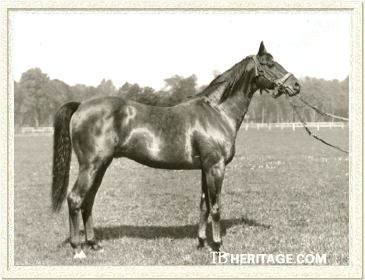 |
|
|
As the main conduit for the Herod male line in the twentieth century, Tourbillon will always be a significant entity to study in the history of the breed. The fact that he was himself a top class runner, one of the foundation sires for Marcel Boussac's French breeding empire and a perennial leading sire in France makes Tourbillon a worthy subject of study in his own right.
Tourbillon, whose name means "whirlwind" in French, was bred by Marcel Boussac (1889-1980) at his Haras de Fresnay-le-Buffard in the heart of the Normandy, the horse breeding center of France. Boussac was the most important French breeder of the Twentieth Century, and his silks, orange jacket with grey cap, were respected, awed and feared on both sides of the English Channel.
Boussac's breeding program, begun in 1914 with a small band of broodmares owned in partnership with Comte Gaston de Castelbajac, made its first significant impression with Sun Briar, a colt who earned his reputation after being sent to America as a youngster. Sold at the 1916 Saratoga yearling sales, Sun Briar became the American champion two-year-old, won the important Travers Stakes at three, and was the best handicapper in training at four. Retired to stud, he was a marked success, and appears in the pedigrees of Polynesian, Tom Fool and Bold Ruler, meaning his influence is widespread.
Boussac purchased Haras de Fresnay-Le-Buffard in 1919 and quickly expanded his operation with astute purchases of fillies, and a colt named Astérus. He bred his initial classic winner when Ramus proved victorious in the 1922 Prix du Jockey Club (French Derby). This was the first of a dozen French Derbies won by Boussac, five Prix de Dianes (French Oaks), six Prix de l'Arc de Triomphes, one Two Thousand Guineas winner, one Epsom Derby, one Epsom Oaks, and two St. Leger winners.
Boussac's greatest runner was Pharis (1936), one of the greatest French horses of the century. Boussac also bred two-time Arc winner Corrida, English and French classic winner Djebel (also Leading Sire), Champion and Leading Sire Ambiorix, French Oaks winner Adargatis and her half-sister, the vastly influential American broodmare La Troienne.
|
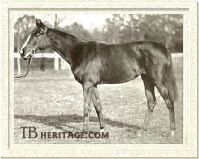
His dam, Durban
| |
Durban
One of Boussac's earliest purchases was the filly Durban, acquired in a package of ten yearlings bred by Madame Duryea, the widow of Herman Duryea, who died in 1916. Duryea's stud was at the Haras du Gazon, which he established on breeding stock largely brought over from America during an era when racing in most of the U.S. was shut down due to anti-gambling laws. These included the outstanding race fillies Frizette and Urania, the champion colt Irish Lad and future classic winner Sweeper II.
|
Many American breeders shifted their operations to France at this time, including August Belmont, William Vanderbilt, A.B. Macomber and Duryea, who had been a close friend and racing partner of W.C. Whitney, who had bred or owned much of Duryea's foundation stock. Duryea was very successful, breeding the 1912 English Two Thousand Guineas winner Sweeper II (Broomstick-Ravello II by Sir Hugo), 1913 Epsom Derby winner Durbar II (Rabelais - Armenia by Meddler), and the 1913 Poule d'Essai des Pouliches (French One Thousand Guineas) winner Banshee (Irish Lad - Frizette by Hamburg).
Durban (by Durbar II - Banshee by Irish Lad out of Frizette) came along in the 1918 crop, and her full sister Heldifann in the 1921 crop; both were purchased by Boussac from Madame Duryea and became foundation mares for him. At two, Durban won the Grand Criterium at Longchamp and the Grand Criterium d'Ostende in Belgium. The next year she won the filly distance classic, the Prix Vermeille at twelve furlongs. Durban's first foal was the classy colt Banstar (1923 c. by Suntar), winner of the Prix Morny and Prix Eugene Adam. In 1927, to the cover of Ksar, she produced another top class runner in Diademe, who crossed the Channel to win the Newmarket Oaks. The next year, Durban produced Diademe's full brother Tourbillon (1928 c. by Ksar).
His Sire, Ksar
Diademe and Tourbillon were offspring of the great French runner and sire Ksar (by Brûleur - Kizil Kourgan by Omnium II), from the same 1918 foal crop as Durban, but bred by another of the great French breeders, Evremond de Saint-Alary. Saint-Alary's stud was Haras de Saint-Pair-du-Mont, which, along with Duryea's Haras du Gazon and Boussac's Haras de Fresnay-le-Buffard, were all in the Normandy region of France. This is the same stud that bred Ksar's sire Brûleur, and Brûleur's sire Chouberski, as well as Ksar's dam Kizil Kourgan, a great racemare in her own right. Both Brûleur and Kizil Kourgan were winners of France's greatest prize at the time, the Grand Prix de Paris.
Saint-Alary's colt Ksar was sold as a yearling to another important French breeder, Edmund Blanc, who purchased the royally-bred colt for 151,000 francs, a new record for a French yearling. Blanc had bought the English Triple Crown winner Flying Fox for a record auction sum in 1899 and installed him at his Haras de Jardy where he sired Blanc's champion colt Ajax in his first crop, born in 1901. Ajax was also a great success at stud and included among his get a good colt named Teddy (1913), who had global ramifciations.
At two, Ksar won the Prix de la Salamandre and second in the Prix Saint Roman (to Soldat II). Unfortunately, Blanc died in December of 1920, so he missed his great colt's absolute domination of French racing for the next two years. Ksar continued to race in the colors of Blanc's wife. At three, he swept all the important events, the Prix Hocquart, Prix Lupin, Prix du Jockey Club, Prix Royal Oak, and Prix de l'Arc de Triomphe. At four, Ksar won a second Arc, also the Prix de Sablons, Prix du Cadran, and Prix du Prince d'Orange. He is considered the first great racehorse in post-World War I France and the epitome of what French racing became known for - a great stayer.
Retired to stud at Blanc's Haras de Jardy, Ksar bacame the Leading Sire in France in 1931, when Tourbillon led his age group. His other top runners included Marcel Boussac's 1933 Prix du Jockey Club winner Thor, 1929 Prix de Diane winner Ukrania, 1937 English Two Thousand Guineas winner Le Ksar and good sire Amfortas. At the age of 17, Ksar was sold to an American partnership and arrived at Kentmere Farm in Virginia in the autumn of 1935. The ocean crossing was difficult, leaving him debilitated, and the great horse served just two seasons at stud in America. Moved to Montana Hall Stud, also in Virginia, he died in 1937 at the age of 19. His American crops produced nothing of note.
Tourbillon on the Turf
The Boussac-bred colt Tourbillon took Ksar's bloodline into the next generation with real strength. He was a good but not great two-year-old, winning two of four starts. An earlier maturing type than his sire, Toubillon debuted on July 23 of his juvenile year, winning the Prix de Verneuil over five and a half furlongs at Chantilly. Returning in the Prix d'Aumale on July 30, he lost to the filly Taraskoia. In his next out, he won the Zukunfstrennen over six furlongs at Baden Baden (Germany), beating Filmenau.
In the championship Grand Criterium, he encountered a heavy racecourse following rains, and ran poorly, coming in sixth behind Indus. At season's end, he was rated far below Barneveldt, the highweight of the juvenile class that season.
|
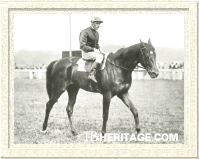
Tourbillon at age three
| |
Like most good stayers, Tourbillon grew into himself and was a different horse as a three-year-old as the distances got longer. Starting in April, he won the Prix Greffulhe at a mile and five sixteenths over Kousor and Indus, who had started favorite off his win in the classic mile Poule d'Essai de Poulains. In May in the Prix Hocquart stretching to a mile and a half, Tourbillon galloped home by three lengths over the consistent Bruledur, and at the end of the month won the Prix Lupin at the mile and five sixteenth distance, again defeating Indus. |
Back at a mile and a half for the Prix du Jockey Club (French Derby), Tourbillon again ate up Bruledur by two lengths, with the talented Barneveldt back in third by a neck. Two weeks later, in the Grand Prix de Paris, which was the most prestigious race on the French turf at the time, Tourbillon was beaten back to third by the winning pair of Barneveldt and Taxodium, over the mile and seven-eighths. In the Prix du President de la Republique in early July he was this time trounced by the improving Barneveldt at a mile and five eigths, going under by six lengths.
Obviously past his peak, the Boussac colt was given a rest until the middle of September. Returning in the Prix Royal Oak (French St. Leger) at a mile and seventh eighth, another improving colt, Deiri, took over and beat Tourbillon, who beat Bruledur by a neck for the place, with Barneveldt in fourth. In the Prix de l'Arc de Triomphe at a mile and a half, Tourbillon suffered a career-ending injury and came home sixth behind the winner Pearl Cap.
With a record of five wins in 11 starts, Boussac took Tourbillon home to stud at Fresnay-le-Buffard for the 1932 season. What he brought back was a top class pedigree, championship level form at a mile and a half, the ability to quicken on command, high energy and good conformation.
Tourbillon in the Stud
Although not quite the physical individual as his sire, Ksar, Tourbilllon had his own superior qualities. He was a lengthy horse with a good shoulder and even more powerful hindquarter, surprising for a classicist but perhaps more indicative of his speedy female line than his staying sireline. His forearm was long and his cannon remarkably short; likewise his gaskin was long and well muscled and hind cannon also short. To fault him, his back was a little long, and his hindleg was flawed with badly angled sickle hocks.
Tourbillon was a high mettled horse, a characteristic noted with his sire and grandsire. The most commonly published conformation photo shows him standing with his head carried high, full of the fire so often described with his character.
His first foals were born in 1933 at Boussac's haras; in 1940 Tourbillon was the Leading Sire in France when DJEBEL won classics in England and France. He was also leading sire in 1942 and in 1945. His first crop came out running, with stakes winners CAPELLA and SERDAB, but the second crop, foals of 1934, produced a crack in GOYA II. The 1935 crop included French Derby winner CILLAS; the 1937 crop came up with DJEBEL; 1939 had ESMERALDA and TORNADO. The 1942 crop was a bumper crop for Tourbillon with CARACALLA and COARAZE; TOURMET came in 1944; TURMOIL in 1945 and AMBIORIX in 1946.
Tourbillon's production tailed off after that, which might be attributed to Boussac spreading his broodmare band among more home sires, which in the mid-1940s now included Tourbillon's two good sons GOYA II and DJEBEL, as well as Jock, and Boussac's returning hero Pharis, who had been taken by the Germans during the Normandy invasion in World War II in 1940 and returned to Haras de Fresnay-le-Buffard in 1945. In 1943, Boussac purchased Edmond Blanc's Haras de Jardy and transferred Tourbillon there. The great stallion was euthanized on July 26, 1954 after having a stroke at the age of 26.
|
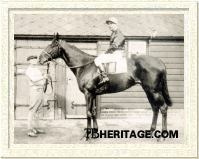
Djebel
| |
Tourbillon's best racing son was DJEBEL (bay colt 1937 out of Loika by Gay Crusader). Bred by Boussac and out of the Boussac-bred mare Loika, a winner by Gay Crusader, his dam had been tagged as a cull and in 1936 and entered in the Newmarket December Sale in foal to Tourbillon. Boussac reconsidered and despite the mare's reproductive problems, kept her, and she foaled out a neat bay colt the next January which he named Djebel. |
In five starts at two, Djebel won twice, but ran second in his debut at Chantilly to a good colt in Lighthouse II. In his next start, the Tourbillon colt won the five-furlong Prix de Chatou at Longchamp, but was beaten again by Lighthouse II in the Prix d'Aumale at Chantilly. In the Prix Morny, Djebel was second to Furane, with Lighthouse II fourth. Shipped to England's Newmarket race course, Djebel dominated the English juvenile crop with a win in the Middle Park Stakes, beating Tant Mieux and Godiva. On this performance, Djebel was awarded the high weight on the year end handicap for French two-year-olds.
At three, Djebel started four times, winning three, beginning with the Prix Lagrange, then made a quick trip over to England to take the Two Thousand Guineas which he won by daylight over Stardust and Tant Mieux. The German invasion in 1940 then brought racing to a halt in France. The German Army also sacked many of the stud farms in Normany, taking most of the best including Boussac's magnificent Pharis, who had retired to stud that spring.
France returned to the races in October, and Djebel ran in the Prix d'Essai at Auteuil, a substitute race for the traditional Poule d'Essai des Poulains and Pouliches (French Two Thousand and One Thousand Guineas), which he won over Maurepas. In the Prix de Chantilly (also run at Auteuil and a substitute for the Prix du Jockey Club this year), Djebel was third in the mile and five eighths to Quicko and Rafaello. At four, Djebel ran six times and won three. He won the Prix Boïard, Prix d'Harcourt and the Prix d'Hedouville. He met his first defeat of the year in the Grand Prix de Saint-Cloud by Maurepas, and that colt beat him again in the Prix de Chantilly. In the Prix de l'Arc de Triomphe, Djebel ran third to Le Pacha and Nepenthe in a blanket finish. At five, Djebel swept through an undefeated season of seven starts, beginning with the Prix des Sablons, and through the Prix Boaird, Prix d'Harcourt, Prix d'Hedouville, Grand Prix de Saint-Cloud, Prix de Chantilly, and Prix de l'Arc de Triomphe.
Djebel retired having shown exceptional class and versatility from age two through five, sprinting and staying as far as a mile and five eighths, although it appeared that he was better at a mile to ten furlongs. A smallish horse with his sire's sickle hocks, he showed the quality, elegance and refinement that was a hallmark of the Boussac type of Thoroughbred and separated that owner's stock from the rest of the breed.
Djebel proved one of the great sires in Europe in the 1940s and 1950s, and was the Leading Sire in France four times, in 1947, 1948, 1949 and 1956. He sired Coronation V (Prix de l'Arc de Triomphe), Galcador (Derby), My Babu (2,000 Guineas), Apollonia (French Oaks, French 1,000 Guineas), Arbar (Ascot Gold Cup), Djelfa (French 1,000 Guineas), Djebellica (Irish Oaks), Montenica (French Oaks), Hugh Lupus (Irish 2,000 Guineas), Clarion (Champion at two), Le Lavandou, Djebe, Djeddah, and Djefou.
His daughter Djenne produced the American runner and sire Olden Times, but several of Djebel's sons made him a better reputation as a sire of sires, if not in their sire dominance, but in the way several of them carried this male line forward. These included Clarion, whose male line survives today through his son Klairon, who sired Luthier (sire of Sagace, Twig Moss and Tip Moss) and Lorenzaccio (sire of Ahonoora, who got Indian Ridge, Dr Devious, Inchinor, and the dam of Azeri). Another son of Djebel to maintain a male line was Hugh Lupus, who sired Hethersett, who got Blakeney and Rarity. A third son of Djebel, My Babu, sired Crozier, Milesian, Our Babu, Primera and Prudent, but his male line continues most strongly through Better Boy, who went to Australia and sired the great racemare Kingston Rose, and the good sire Century (sire of Centaine).
Djebel's son Le Lavandou sired Le Levanstell, establishing a dynasty of stayers with Le Moss, Levmoss, Sarah Siddons, Sweet Mimosa and the speedier My Swallow. Another sire son of Djebel's worth noting is Djeddah, a high class runner who went to stud in America where he was a good sire but not great. Djeddah's daughters, however, have wielded a heady influence, getting the likes of Never Bend, Bold Reason, Mr. Leader, and Proud Clarion. Another daughter, Golden Beach, established a strong family that has produced Clever Trick, Ascot Knight, Alydeed, Petit Loup, and Bounding Away.
Djebel died at Haras de Fresnay-le-Buffard in July of 1958 at the age of 19. Stablemate Pharis had died the year before, and their deaths marked the beginning of the end of Boussac's breeding empire.
|
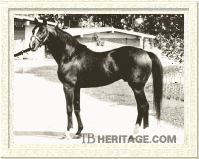
Coaraze
| |
Behind Djebel, Tourbillon sired another top class son in COARAZE (bay colt 1942 out of Corrida by Coronach). He was closely related to an earlier Boussac star, GOYA II, who was by Tourbillon and a half brother to Coaraze's great dam, Corrida. She was Marcel Boussac's two-time Arc de Triomphe champion, who had a troubled production record, with only two foals to live. Coaraze, born in 1942, was her last and the only one to survive to adulthood. She was seized by the Germans in World War II and never seen again.
|
Coaraze followed his dam's lead and among his three wins at two included the important Prix Morny, which Corrida had won ten years before. At three, he won the Prix Daphnis, Prix du Jockey Club, and Prix Jacques le Marois. He was second in the Poule d'Essai des Poulains (to Mistral), and fourth in the Grand Prix de Paris (won by stablemate CARACALLA II) and fourth in the Arc. His performances made him the highweight of his division.
At four, Coaraze, won the Prix Daphnis et Chloe, Prix d'Ispahan, Grand Prix de Saint-Cloud, second in the Rous Memorial Stakes and Great Yorkshire Stakes in England. third in the Prix des Sablons, and unplaced in the Champion Stakes. Returning as a five-year-old, Coaraze won a second Prix d'Ispahan, the Grand Prix de Ville de Vichy, and seconds in the Coronation Cup (to Chanteur II), Grand Prix de Saint-Cloud (to Yong Lo in an unlucky run), Prix d'Harcourt (also to Yong Lo), and Great Yorkshire Stakes (to High Stakes).
Retired to Boussac's stud at six in 1948, probably to replace GOYA II who was sold to America for the 1948 season, Coaraze stood alongside the aging Tourbillon, his son DJEBEL, the mighty Pharis and his son Ardan. Competition was tough for mares, and Coaraze failed to make the cut. Although he got the classy filly La Mirambule, winner of the Prix Vermeille (and dam of Nasram and Tambourine), and the good colt Canthare (who was out of a mare by GOYA II, so inbred 2x3 to Tourbillon), he sired little else of value. Daughter Alba Nox produced Grand Prix de Paris winner White Label. Coaraze was sold to Brazil in 1954 and became a leading sire there, dying in 1970 at the age of 28. His good Brazilian-bred son Emerson was returned to stand in France where he got the French Oaks winner Rescousse. Son Canthare went to stud in Argentina where he became an important sire.
|
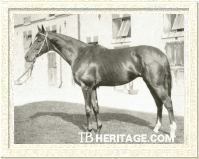
Caracalla
| |
From the same crop as COARAZE came CARACALLA (bay colt 1942 out of Astronomie by Astérus), a third generation Boussac-bred out of one of his most prolific broodmares. Astronomie also produced the great stayer Marsyas, Epsom Oaks winner Asmena, and Ascot Gold Cup winner Arbar. Unraced at two, CARACALLA ran undefeated through two seasons. At three, he won the Prix Bay Middleton, Prix Reiset, Grand Prix de Paris (beating Derby winner Chanteur II) and Prix Royal Oak (French St. Leger). At four, he won the Prix Edgard Gillois, Prix de Dangu, Ascot Gold Cup, and Prix de l'Arc de Triomphe. That season, the shortest race he ran was the twelve furlongs Arc; the Edgard Gillois was nineteen furlongs, and the Gold Cup and Prix Dangu were both at twenty furlongs.
|
|
Boussac retired CARACALLA back to his home stud, but the horse, like many professional stayers, lacked the brilliant speed to be a successful sire. His best runners were the Boussac-bred fillies Caralina, winner of the Prix de Pomone, and Caraida, winner of the Prix Fille de l'Air, also Persepolis, Claudius, Muscadin, and Pointe d'Acier. Caracalla got a few good daughters, led by Cygnet, whose son Wolver Hollow won the Eclipse Stakes. Daughter Niobe became the granddam of stakes winner Prince de Galles, sire of the international Group/Grade 1 winner Noble Dancer. Daughter Persepolis became the granddam of Group 1 winner Guadanni, a son of Luthier and the owner of a pedigree linebred to Djebel and his sire Tourbillon. Caracalla's lack of success led to his sale to New Zealand late in life.
|
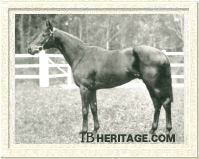
Ambiorix
| |
One of the last good sons of Tourbillon, AMBIORIX (dark bay colt 1946 out of Lavendula by Pharos) was bred by Marcel Boussac, and was a close relative to the year older Guineas winner My Babu (by Tourbillon's son DJEBEL, out of Perfume II, a Badruddin daughter of Lavendula). Ambiorix took only three starts at two to make his point. Unplaced in his debut, the Prix de Chatou at Longchamp, he was sent to Goodwood in England for the Selsey Maiden Stakes and won the six-furlongs event by six widening lengths. Back in his homeland, Ambiorix won the championship in the Grand Criterium by two lengths.
|
At three, Ambiorix sprang back on the scene looking like a superhero, winning the Prix Greffulhe, then the Prix Lupin in quick succession, both at ten furlongs. In the Prix du Jockey Club, he hit his distance limitations and failed to stay the additional quarter mile by a half length to Good Luck, who he had beaten in the Prix Lupin. He also lost the Prix Hocquart to Val Drake, then was retired with four wins in seven starts.
Boussac sold Ambiorix for $250,000 to an American syndicate headed by Arthur Hancock of Claiborne Farm, where the colt stood his first season at stud in 1950. Here he was a remarkable success, getting 51 stakes winners in a long stud career with 423 foals. His best offspring included High Voltage (champion fillly at two and C.C.A. Oaks winner at three), Hitting Away (Withers Stakes, Dwyer Stakes, etc.), Pinjara, Pleasure Seeker, Rash Statement, Ambiopoise (sire of Faraway Son and Twice Worthy), Count Amber (sire of Belmont winner Amberoid), Ambehaving (sire in Florida), and Amber Morn (sire of Queen's Plate winners Royal Chocolate and Amber Herod).
Ambiorix didn't get a classic level colt,and in fact, his fillies were better than his colts at two and three, like High Voltage, Rash Statement, and Sarcastic. His daughters were excellent broodmares and nicked particularly well with Bold Ruler, getting Vitriolic, Stupendous, Bold Commander, Bold and Brave, also with Ribot, getting Ragusa and Irradiate. Outside of Hitting Away, his best sons got better with age and tended to be good handicappers both on dirt and turf. His best sons were just marginally successful sires, although stakes-placed son Sheet Anchor was a very successful son in Argentina. Ambiorix was pensioned from stud duty and died in January, 1975 at the age of 29. He is buried at Claiborne Farm in Kentucky.
|
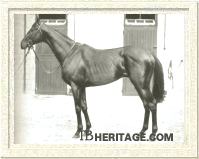
Cillas
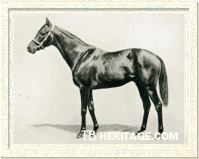
Tourment
| |
Tourbillon's son CILLAS (brown colt 1935 out of Orlanda by Craig an Eran) owned a pedigree typically Boussac in character, since his breeder was known to try close inbreeding. Cillas's granddam was the Duryea-bred mare Frizelle, by Durbar II out of Frizette, so a three-quarter sister to Tourbillon's own dam, Durban (by Flying FoxDurbar II - Banshee by Irish Lad - Frizette). So Cillas was inbred 3x3 to Durbar II and 4x3 to Frizette. Cillas was the Highweight at two in France, and at three, he won the Prix Greffulhe, then became the first of Tourbillon's two winners of the Prix du Jockey Club (French Derby). He also won the Prix Jacques Le Marois. CILLAS was sent to stud in Ireland, but died in 1946, leaving no important offspring.
Although Boussac used Tourbillon as virtually a private stallion, there were a few outside breeders granted access, and one of these was Baron Geoffrey de Waldner, who bred TOURMENT (bay colt 1944 out of Fragment by Shred). His pedigree was interesting since he was inbred 3x4 to Ksar's sire Brûleur. A winner of four races, at two, he was third in the Gainsborough Stakes in England. Returning to France, Tourment won the Poule d'Essai des Poulains (French 2,000 Guineas), and Prix Royal Oak (French St. Leger). He was also second in the Prix du Jockey Club (to Sandjar by a head), Grand Prix de Paris (to Avenger), Prix Lupin, Prix des Sablons, Prix du Bois, and third in the Prix du Cadran.
|
At stud, Tourment was a useful sire, getting the Prix de Diane (French Oaks) winner Cerisoles, and a few good broodmares in Seed Pearl, dam of Prix de Diane winner Fine Pearl; and Sanelta, dam of Prix du Jockey Club winner Sanctus.
Getting back to the common theme, Marcel Boussac bred Tourbillon's champion daughter ESMERALDA (bay filly 1939 out of Sanaa by Astérus). At two, she won the Prix de la Rochette, Prix Morny and Prix de la Foret, earning her division championship in the process. At three, Esmeralda won the Prix Penelope, Poule d'Essai des Pouliches (French 1,000 Guineas), and was second in the Prix de Diane (French Oaks), Prix de Flore; and third in the Prix Vermeille. At four, she won the Grand Prix de Marseille. As a broodmare, Esmeralda produced the great race filly Coronation V (by her paternal half-brother Djebel), winner of the Prix de l'Arc de Triomphe at three.
|

Goya
| |
Although not a classic winner, Tourbillon's son GOYA (bay colt 1934 out of Zariba by Sardanapale) was a champion in his own right and later, a leading sire. He was closely related to Coaraze, being by the same sire, and he was a half-brother to Coaraze's dam, Corrida. He was also the last good runner out of his dam, Zariba, one of Boussac's foundation mares. At two, Goya raced in England, where he won the Gimcrack Stakes, was second in the Middle Park Stakes (to Fair Copy) and third in the National Breeders' Produce Stakes (behind Full Sail and Foray). At three, he won the prestigious St. James's Palace Stakes (beating Full Sail), was second in the Two Thousand Guineas (to Le Ksar) and Champion Stakes (to the American-bred Flares), although unplaced in the Derby.
|
At four, GOYA won the Prix Lamarque in his first attempt on his native French soil, prior to that being third in the Coronation Cup. At five, he won the Prix Edmund Blanc, Prix des Sablons, and Braune Band von Deutschland,, was also third in the Grand Internatioal d'Ostende. At six (1940), Goya's career was stalled by the German invasion, but he won a second Prix des Sablons, Prix Boïard, Prix Massine, and Prix Trois-ans et Au Dessus. At five and six he was considered the best older horse in training in France. Whether it be the conditions or his maturity, Goya was a much better horse on the Continent than he was in England.
Boussac retired his star back to Haras de Fresnay-le-Buffard where he stood his first season in 1941. GOYA was an immediate success, and the Leading Sire in France in 1947 and 1948. His best included the Epsom Oaks winner Asmena, champion Nirgal, Prix du Jockey Club winners Good Luck and Sandjar, Poule d'Essai des Pouliches winners Corteira and Galgala, and the excellent Goyama. Thus it was surprising that Boussac sold his champion stallion to America for the 1948 season, where he stood at Almahurst Farm. [During this period, Boussac sold several of his best bred colts and stallions to America including GOYA, Ardan, Djeddah and Heirocles.] In the U.S., GOYA wasn't quite the success, but he got Arrogate, Artismo, and Goyamo. He died in 1958 at the age of 24.
|
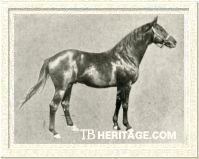
Marcius
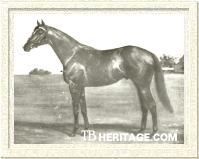
Timor
| |
Some other of the best runners by Tourbillon included GASPILLAGE (colt 1935 out of La Gasse by Son-In-Law), winner of the Poule d'Essai des Poulains, and one of his sire's few offspring not bred by Boussac. Another of those rarities was TORNADO (bay colt 1939 out of Roseola by Swynford), winner of the Prix Lupin and second in the Prix du Jockey Club (to Magister) and the Arc de Triomphe (to DJEBEL). Tornado was a good sire, getting Poule d'Essai de Poulains Tyrone, Ascot Gold Cup winner Aquino II, Tiepoletto, and Fontenay. Tourbillon's TURMOIL (bay colt 1945 out of Blue Iras by Blue Skies) was a top stayer, winner of the Prix du Cadran and Grand Prix de Deauville. He sired Grand Prix de Paris winner Popof. FORT NAPOLEON (colt 1947 out of Roquebrune by Motrico) won the Prix d'Ispahan and Prix Jacques le Marois. He became an important sire in Brazil. TIMOR (chestnut colt 1944 out of Samya by Nimbus) won the Prix Hocquart, and was sent to Argentina where he sired the champion Pronto. MERIDIEN (1935 out of Meriem by La Farina) sired Medium, who in turn, got Misti. MARCIUS (bay colt, 1934, out of Coeur-a-Coeur by Teddy) was a stayer in South Africa, winning the 1-3/4 mile Goldfields Handicap and dead-heating for the Len Harvey Memorial over two miles. He was later was in the top ten on the sires list five times in South Africa, and was three times champion broodmare sire.
|
As a stallion, Tourbillon helped his breeder/owner Marcel Boussac maintain his breeding empire at the very top, to the point that in the 1940s and 1950s, French-breds successfully invading England were not only commonplace, but a serious tradition. A direct result of this was a change in the Stud Book itself.
Due to his American ancestry through his dam Durban, with non-Stud Book ancestors in both Durbar II and Banshee's pedigree, all descendants of Durban and Tourbillon were considered "half-bred" by English standards. The famous "Jersey Act" of 1913 had barred such half-breds from being registered in the General Stud Book, but not from racing in England. The rise of the great French-bred horses - mostly the children and grandchildren of Tourbillon, combined with the success of many American-breds led to the repeal of the Jersey Act in 1949.
Tourbillon's influence is widespread and extended beyond France to England, America, South America and Australia and everywhere where Thoroughbreds are raced and bred.
-- Anne Peters |
|
|
|

